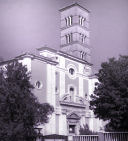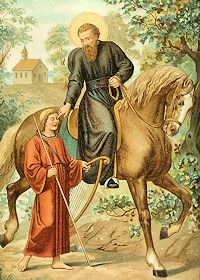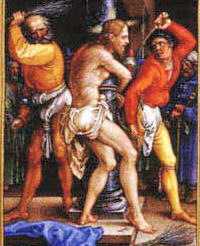Lent: March 26th
Wednesday of the Third Week of Lent
Other Commemorations: St. Ludger, Bishop (RM)
» Enjoy our Liturgical Seasons series of e-books!
Today we have a venerable Lenten Mass. This Mass is best understood by remembering that the ancient catechumens (or prospective converts) used to come for instructions to the first part of Lenten Masses. The catechumens heard the readings and homily, and then left the church. The offertory procession and remainder of the Mass were for the faithful. This Wednesday was the first “scrutiny,” or test, for the catechumens. That test was on the Commandments of God. Both readings, consequently, are about the Commandments. —The Vatican II Weekday Missal
The Roman Martyrology commemorates St. Ludger of Utrecht (c. 743-809), a missionary among the Frisians and Saxons, founder of Werden Abbey, and the first Bishop of Münster in Westphalia. He has been called the "Apostle of Saxony."
Meditation for Wednesday of the Third Week of Lent—Obedient Unto Death
This we have frequently heard and have often meditated upon — but have we conformed our lives to this model so worthy of imitation? Must we not confess that we strive often to appear superior in our natural and spiritual talents? Do we not all too frequently boast of our accomplishment as if no one had ever equalled us? Does not history show how man in his pride has exceeded al bounds, seeking to place himself on a level with — and at times even above — Almighty God?
Yet Christ, Who was true God, "emptied Himself, taking the nature of a slave and being made like unto men, and appearing in the form of man, He humbled Himself, becoming obedient to death, even to the death of the Cross" (Phil. 2:7). It is precisely in this deep humiliation that He wishes to continue dwelling among us. Every Crucifix tells us this: "Learn of Me, for I am meek and humble of heart…I have been obedient unto death. . . I am full of love and patience."
Most of us will go to any lengths to cancel our degradation from our fellow men, while trying to give others the most favorable possible impression of ourselves. King Agesilaus of Sparta was a most excellent ruler, celebrated for his justice and wisdom, but he was most unattractive physically. At his death, he strictly forbade any portrait to be made of himself, whether painted or sculptured. The king feared lest such a visible remembrance of him might lessen the love and esteems which he had gained among his people during his lifetime because of his just and wise rule.
But the Son of God did not fear to approach us in His deepest humiliation and ignominy. He displays Himself to us in all His woe, summoning us to contemplate Him as the Man of Sorrows, asking that we grow in humility and patience by studying His own resignation to the Will of His Heavenly Father. In the gripping words of the prophet Isaias: "There is no beauty in him, nor comeliness; and we have seen him, and there was no sightliness that we should be desirous of him: Despised, and the most abject of men, a man of sorrows, and acquainted with infirmity; and his look was as it were hidden and despised, whereupon we esteemed him not" (Is. 63:2-4).
By means of these liturgical texts, let us penetrate the portrait of our sorrowful Redeemer, learning from Him all the virtues necessary that, in St. Paul's words, "Christ may be formed in us" (Gal. 4:19). This portrait of the patient, loving crucified Savior, Who out of deference to the Will of His Heavenly Father freely went forth to death for us, must stand out vividly before our souls' eyes before we can really conform our life, sacrifice, sufferings and death to His. Then "from glory to glory" His portrait will gradually take form in us in transcending beauty, and having suffered with Christ, we shall, according to God's own promise, "participate in His resurrection."
What better prayer during Lent could rise form the depths of our hearts than that of St. Gertrude, kneeling before her Crucifix: "Accept, O compassionate Jesus, this my prayer with that exceeding love wherewith Thou didst endure a bitter death and didst offer it, together with all the fruit of Thy most sacred Humanity, to God the Father on the day of Thine Ascension; and by the depth of those wounds which scarred Thy Flesh and pierced Thy Hands and Feet and Heart, I beseech Thee, raise me up, who am steeped and sunk in sin, and render me well pleasing to Thee in all things."
—Bernard Strasser, The Dews of Tabor

Wednesday of the Third Week of Lent
Station with San Sisto il vecchio (St. Sisto):
This church was called "San Sisto il vecchio" because it is the oldest convent in Rome of the sons of the Saint of Callaroca. The current construction is quite recent; in fact it was built in 1700 by the Dominican Pope Benedict XIII (1724-1730). He certainly did it to honor the memory of the Founder of the Order, San Domenico, who had his first Roman residence here; Honorius III, after having approved the Order of Preachers, gave him this temple. Tradition has it that at this church Pope Sixtus II met with San Lorenzo to whom he predicted the martyrdom which, moreover, happened after three days. As of 2019, there is a temporary closure. Currently the substitute Station Church is Sant’Andrea della Valle (St Andrew in the Valley), dedicated to St. Andrew the Apostle. In 2021 and 2022, the Mass was celebrated at Santi Nereo e Achilleo.
For more on San Sisto il vecchio, see:
- The Station Churches of Rome
- Rome Art Lover
- Roman Churches
- PNAC
- Aleteia
- Station Church
- The Catholic Traveler
For more on Sant’Andrea della Valle, see:
For further information on the Station Churches, see The Stational Church.
St. Ludger
 St. Ludger was born in Friesland about the year 743. His father, a nobleman of the first rank, at the child's own request, committed him very young to the care of St. Gregory, the disciple of St. Boniface, and his successors in the government of the see of Utrecht. Gregory educated him in his monastery and gave him the clerical tonsure. Ludger, desirous of further improvement, passed over into England and spent four years and a half under Alcuin, who was rector of a famous school at York.
St. Ludger was born in Friesland about the year 743. His father, a nobleman of the first rank, at the child's own request, committed him very young to the care of St. Gregory, the disciple of St. Boniface, and his successors in the government of the see of Utrecht. Gregory educated him in his monastery and gave him the clerical tonsure. Ludger, desirous of further improvement, passed over into England and spent four years and a half under Alcuin, who was rector of a famous school at York.
In 773 he returned home, and St. Gregory dying in 776, his successor, Alberic, compelled our Saint to receive the holy order of priesthood and employed him for several years in preaching the Word of God in Friesland, where he converted great numbers, founded several monasteries, and built many churches.
The pagan Saxons ravaging the country, Ludger traveled to Rome to consult Pope Adrian II, what course to take, and what he thought God required of him. He then retired for three years and a half to Monte Casino, where he wore the habit of the Order and conformed to the practice of the rule during his stay, but made no religious vows.
In 787, Charlemagne overcame the Saxons and conquered Friesland and the coast of the Germanic Ocean as far as Denmark. Ludger, hearing this, returned into East Friesland, where he converted the Saxons to the Faith, as he also did the province of Westphalia. He founded the monastery of Werden, twenty-nine miles from Cologne.
In 802, Hildebald, Archbishop of Cologne, not regarding his strenuous resistance, ordained him Bishop of Munster. He joined in his diocese five cantons of Friesland which he had converted and also founded the monastery of Helmstad in the duchy of Brunswick.
Being accused to the Emperor Charlemagne of wasting his income and neglecting the embellishment of churches, this prince ordered him to appear at court. The morning after his arrival the emperor's chamberlain brought him word that his attendance was required. The Saint, being then at his prayers, told the officer that he would follow him as soon as he had finished them. He was sent for three several times before he was ready, which the courtiers represented as contempt of his Majesty, and the emperor, with some emotion, asked him why he had made him wait so long, though he had sent for him so often. The bishop answered that though he had the most profound respect for his Majesty, yet God was infinitely above him; that whilst we are occupied with Him, it is our duty to forget everything else. This answer made such an impression on the emperor that he dismissed him with honor and disgraced his accusers.
St. Ludger was favored with the gifts of miracles and prophecy. His last sickness, though violent, did not hinder him from continuing his functions to the very last day of his life, which was Passion Sunday, on which day he preached very early in the morning, said Mass towards nine, and preached again before night, foretelling to those that were about him that he should die the following night, and fixing upon the place in his monastery of Werden where he chose to be interred.
He died accordingly on the 26th of March, at midnight.
—Excerpted from Lives of the Saints, by Alban Butler, Benziger Bros. ed. [1894]
Symbols and Representation: bishop holding a cathedral; bishop holding a church and a book; bishop reciting his Breviary; bishop with a swan on either side; bishop with a goose or geese
Patronage: diocese of Essen, Germany; diocese of Münster, Germany; Billerbeck, Germany; Helmstedt, Germany; Münster, Germany; Saxony, Germany; Werden, Germany; Bant-Rutten, Netherlands; Deventer, Netherlands; Dronten, Netherlands; East Frisia, Netherlands; Groningen, Netherlands; Hengelo, Netherlands; Lichtenvoorde, Netherlands; Loenen, Netherlands.
Highlights and Things to Do:
- Read more about St. Ludger:






